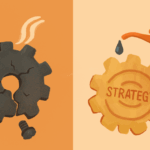There isn’t one clear-cut path to podcast discovery or listening. A user could happen to listen to one episode because it’s embedded as an audio file on a webpage, or they might subscribe to the show and delete the downloads from their player before they even listen to it.
Not only that, but listeners have many options available to them when it comes to accessing an episode. They could play it straight from a webpage on their desktop computer or mobile phone, subscribe to a show using one of several podcast players, or directly download only one episode through that player. With this many possible combinations, it becomes a challenge for podcast hosting services to effectively deliver accurate data.
How Data is Gathered
While it’s a challenge for podcast hosting sites to gather data, it’s certainly not impossible. In its simplest form, each podcast is an RSS feed which is submitted to podcast players such as Apple Podcast, RadioPublic, and Overcast. Depending on the user’s settings, these players “crawl” the RSS feed on a regular basis — it could be every few minutes or hours to every few days. When the RSS feed indicates there is a new episode, this pings the RSS feed and is often shown on podcast hosting sites as a download for the podcaster. RSS feeds are pinged on several occasions:
- When a subscriber’s player automatically downloads an episode
- When a user manually downloads an episode
- When a listener downloads an episode directly from the RSS feed (such as on a landing page)
Podcasters are therefore able to access the number of downloads each episode receives, but these are not always equivalent to the number of listens. We have been spoiled by services such as YouTube that provide the number of users who watch a certain percentage of our content, but with podcasting, we aren’t as fortunate. After a user downloads an episode, podcasters are unable to know what happens next. Does the user listen to half of it? Or maybe they loved it so much that they listed three times! No matter the situation, podcasters are not yet privy to this information. Apple has provided promise of improvements, but these changes will only apply to users who consent to sharing their data and use the Apple Podcast app.
Where to Find Podcast Data
Podcast hosting sites provide users with a limited amount of data, as well as different variables to consider. These can include the number of downloads per episode or the number of downloads per month, the location of users who downloaded episodes, and other demographic data.
It’s important for podcasters to invest in a podcast-specific hosting service, despite the attractiveness of free services such as SoundCloud. These podcast hosts are built to support this unique content, while SoundCloud does not provide robust data as an audio-hosting service. Some podcast hosting services include:
“How Many Subscribers Do You Have?” And Other Questions You Can’t Answer
Of course, with limited data, it can be challenging to prove to campus stakeholders that the podcast is “working” for the institution. This is where you need to get creative with data and measure more than the podcast player provides.
Answering the Most Common Question
The first question most podcasters are asked is, “how many listeners do you have?” Of course, this is impossible to determine because users can listen to several episodes (we hope!) or listen to the same episode more than once — which skews download data by an unknown amount. To answer this question, it’s up to you to make a few assumptions and best guesses.
Because most users’ players crawl podcast RSS feeds at least once per day, it’s fair to estimate that the number of reported downloads in the first 24 hours is roughly equivalent to the number of subscribers, especially if this number stays relatively consistent (but grows!) episode over episode. In order to make this number more accurate, hold off on all promotion until the next day. That way, you won’t have an inseparable combination of subscriber downloads and promotion downloads to report on.
Other Measurements to Mark Success
The first 24 hours after a podcast episode goes live tells its own story, but data collection shouldn’t stop there. Many listeners don’t have the chance to get around to a podcast episode the day it comes out, which means podcasters should also consider the days and weeks following an episode launch. Over time, comparing these numbers (such as the number of downloads in the first week) between episodes will help podcasters understand if the podcast listener base is growing, shrinking, or stalling out.
No matter the technique and frequency of data collection for podcasts, it’s important to maintain consistency in order to truly determine its growth.
So, How’s the Podcast Doing?
Despite what it looks like, this question is possible to answer for campus stakeholders! It does require a level of creativity and making assumptions, but before even accessing the data, it’s most important to revisit the initial goal of the podcast.
The goal is the key to unlocking what determines if the podcast is “doing well” or needs improvement. It’s unlikely that the goal of the podcast was to “get a lot of listeners,” or even have a certain number of subscribers. Rather, it was most likely to help with a larger goal such as alumni relations efforts or yield campaigns, which means the measure of success is not always the number of downloads.
Other Creative Measurement Tactics
Outside of listener numbers, what data can help stakeholders understand the impact of the podcast on campus or on certain initiatives? It’s important to consider both quantitative and qualitative data during collection and reporting, which can include:
- Reviews on Apple Podcast or other players
- Website traffic (if the podcast is hosted there)
- Social media chatter
- Anecdotal feedback
Of course, this is not to discount a growing number of downloads episode over episode or month over month. However, gathering other types of data gives a more robust picture of how the podcast has grown or where it needs improvement.
Social Listening
Sites such as Twitter, Facebook, and LinkedIn are a great way to connect with the listening audience, as well as determine the sentiment around a podcast. Use keywords based on the podcast or institution in order to gather this qualitative data, and provide those sentiments to stakeholders on campus!
Website Traffic
By creating a landing page for each episode of the podcast, as well as a central landing page for users to learn more about the show, podcasters are able to leverage Google Analytics data to learn more about the number of visitors as well as demographic data. This information can be helpful in order to determine if the target audience is being reached, as well as the path users take between episode landing pages.
Asking for Feedback
What better way to get feedback on a podcast than to ask! Often, podcasts will promote a listener survey within the content of each episode, asking users to provide simple demographic data as well as feedback for the producer. Having trouble getting listeners to participate? Everyone loves the chance at a prize!
In order to receive more consistent feedback, create a generic email address for users to send their comments to. Don’t forget to promote this address as frequently as possible, both in the content of the episode as well as in the show notes and online!
If Numbers Really Do Matter…
It’s easier said than done for podcasters to ignore the numeric data and rely on qualitative data such as reviews and social media posts to paint a larger picture. If stakeholders on campus are more concerned about the number of downloads, consider this:
- The median number of downloads for podcasts is 200 per month
- The top 10% of podcasts receive 3,400 downloads per month
- The top 5% of podcasts receive 9,000 downloads per month
- The top 1% of podcasts receive 50,000 downloads per month
Podcasting is still new in the higher education space, and while many podcasters aspire to be “the next Serial,” we must take a realistic look at our goals, the audience, our content, as well as the podcasting landscape in order to determine how effective our efforts are.





